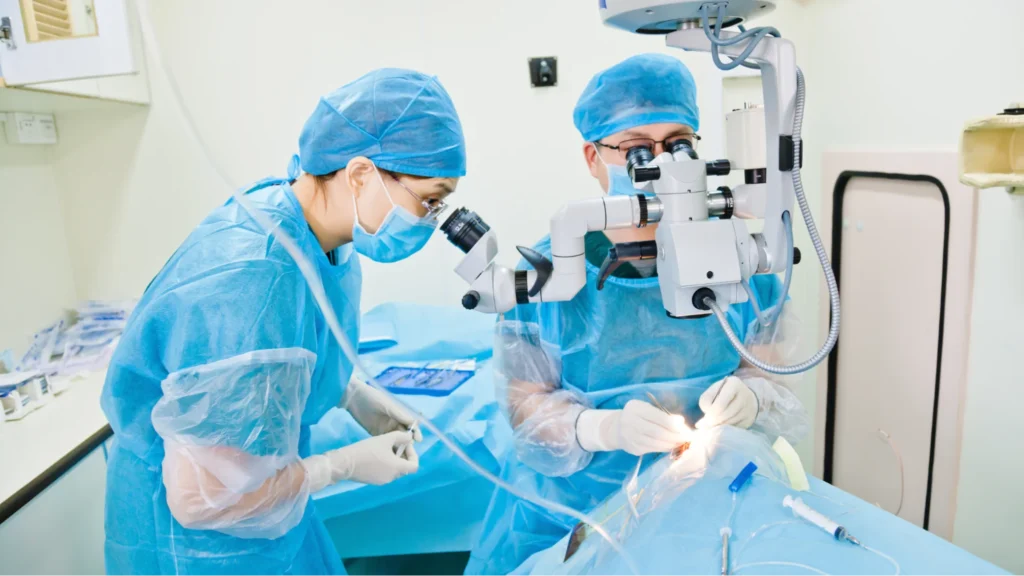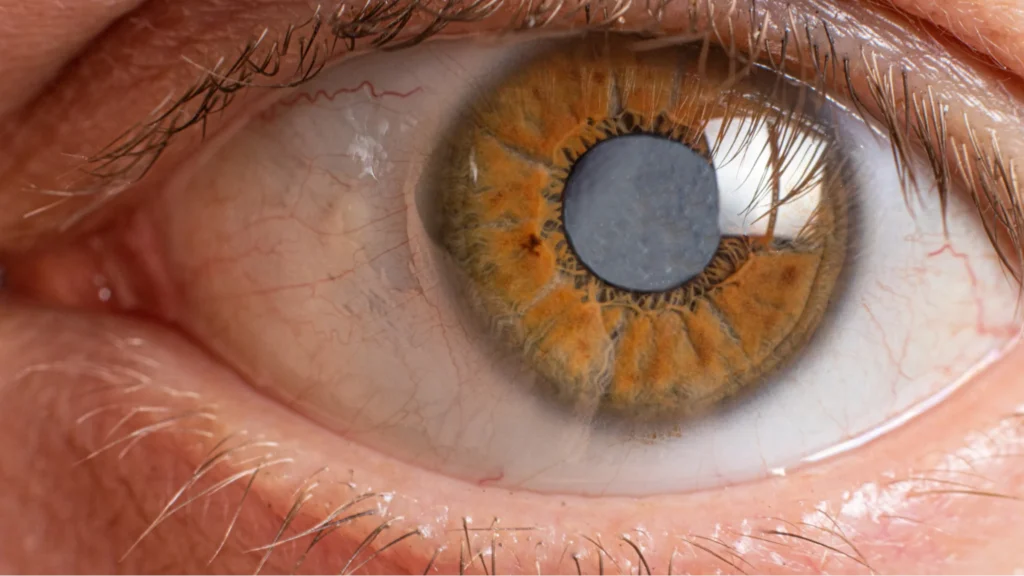The street lights have halos around them now. What used to be a quick evening drive to the grocery store has become an exercise in caution, with oncoming headlights creating glare that makes you grip the steering wheel a little tighter. Maybe you’ve started avoiding night driving altogether, or perhaps you’ve caught yourself tilting a restaurant menu toward the light, wondering when the print got so small.
These aren’t just normal signs of aging – they could be your first encounter with cataracts. If you’re reading this, chances are you or someone you care about has started noticing these vision changes, and you’re looking for real answers about what’s happening and what comes next.
Here’s what you need to know right upfront: cataracts affect more than half of Canadians over 60, they’re completely treatable, and you have more control over the timing and outcome than you might think. This guide will give you the straight facts about cataracts, from understanding what’s actually happening in your eye to knowing when it’s time to take action. You’ll learn to recognize the early warning signs, understand your treatment options, and feel confident making decisions about your eye health and independence.
What Are Cataracts, Really?
Think of your eye’s natural lens like the lens of a camera. It needs to be crystal clear to focus light properly onto your retina. A cataract happens when this lens becomes cloudy or opaque, kind of like looking through a foggy window.
Your eye’s lens is made up mostly of water and proteins. As you age, these proteins can clump together, creating cloudy areas that block or scatter light. This clouding is what we call a cataract, and it’s the reason things start looking blurry, dim, or hazy.
The name “cataract” actually comes from an old Greek word meaning “waterfall”, because early doctors thought it looked like water was falling over the eye. While that’s not what’s actually happening, it’s a pretty good description of how the world can start to look when cataracts develop.
Most cataracts develop slowly over the years, which is why you might not notice them right away. Your brain is pretty good at adapting to gradual changes, so the symptoms often sneak up on you.
How Cataracts Affect Your Vision
Cataracts don’t just make things blurry – they can affect your vision in several different ways, and understanding these changes can help you recognize what’s happening.
- Cloudy and blurred vision: This is usually the first thing people notice. It might start with just a small area of cloudiness that doesn’t bother you much. Over time, the cloudy area grows larger, making it harder to see clearly. You might find yourself cleaning your glasses more often, thinking that’s the problem.
- Increased sensitivity to light and glare: Bright lights can become uncomfortable, and you might notice more glare from headlights when driving at night. Sunlight might seem harsh, and you could find yourself reaching for sunglasses more often, even on overcast days.
- Difficulty with night vision: Many people first notice their cataracts when driving after dark becomes challenging. Street lights might have halos around them, and it becomes harder to judge distances or see clearly in low-light conditions.
- Colours appearing faded or yellowed: Cataracts can make colours look less vibrant or give everything a yellowish tint. You might not notice this gradual change until after treatment, when colours suddenly seem bright and clear again.
- Double vision in one eye: Sometimes cataracts can cause double vision or multiple images when you look through the affected eye alone. This happens when the cataract scatters light in different directions.
Early Signs of Cataracts to Watch For
Recognizing the early signs of cataracts can help you stay ahead of vision problems and maintain your quality of life. Here’s what to look out for:
- Reading and close-up work becomes harder: You might find yourself holding books, menus, or your phone farther away to see them clearly. The small print that used to be manageable suddenly requires better lighting or magnification.
- Frequent changes in your glasses prescription: If you’re finding that your glasses prescription needs updating more often than usual, cataracts could be the culprit. The changing shape and clarity of your lens affects how well your current prescription works.
- Trouble with activities you love: Whether it’s golfing, photography, or needlework, activities that require sharp vision might become more challenging. You might notice it’s harder to follow a golf ball’s flight or that your camera’s viewfinder looks hazier than usual.
- Increased difficulty driving: Beyond the night vision issues, you might find daytime driving more challenging, too. Road signs might be harder to read from a distance, or you might have trouble seeing lane markings clearly.
For people with diabetes or those who use steroid medications regularly, these changes might happen faster and require more frequent monitoring.
Understanding Cataract Risk Factors
While aging is the biggest risk factor for cataracts, several other factors can increase your chances of developing them or speed up their progression.
- Age-related cataracts – Most cataracts are simply a result of getting older. By age 60, more than half of people have some degree of cataract formation. By age 80, nearly everyone has cataracts or has had cataract surgery.
- Medical conditions – Diabetes significantly increases your risk of developing cataracts, and they tend to progress faster in people with diabetes. High blood pressure and obesity can also contribute to cataract development.
- Medications and treatments – Long-term use of corticosteroid medications, whether as eye drops, pills, or injections, can increase cataract risk. Some other medications and radiation treatments can also contribute to cataract formation.
- Lifestyle factors – Smoking, excessive alcohol consumption, and prolonged UV exposure without proper eye protection can all increase your risk. That’s why wearing good sunglasses and a wide-brimmed hat outdoors is so important.
- Eye Injuries and inflammation – Previous eye injuries, surgeries, or chronic inflammation can lead to cataracts developing earlier than they might otherwise.
Understanding Your Treatment Options

The treatment approach for cataracts depends on how much they’re affecting your daily life. There’s no rush to make decisions, and you have time to consider your options carefully.
Early stage management
In the early stages, you might not need any treatment at all. Simple changes like using brighter lights for reading, wearing anti-glare sunglasses, or updating your glasses prescription might be enough to manage symptoms.
When surgery becomes an option
Cataract surgery becomes worth considering when the cataracts start interfering with activities that matter to you. This might be when you can’t read comfortably, when driving becomes difficult, or when you can’t enjoy hobbies that require clear vision.
The surgery process
Cataract surgery is one of the most successful procedures in all of medicine. The cloudy lens is removed and replaced with a clear artificial lens called an intraocular lens (IOL). The procedure typically takes less than 30 minutes and is done on an outpatient basis.
Lens options
You’ll have choices when it comes to the type of IOL. Basic lenses can restore clear distance vision, while premium lenses might reduce or eliminate your need for glasses. These options include lenses that correct astigmatism or provide both distance and near vision.
Living with Cataracts: Practical Tips
While you’re deciding on treatment or waiting for the right time for surgery, there are ways to make living with cataracts easier.
- Lighting improvements: Good lighting can make a huge difference. Use bright, direct lighting for reading and close work. LED bulbs provide excellent light quality and last longer than traditional bulbs.
- Reducing glare: Anti-reflective coatings on your glasses can help reduce glare. Wearing a brimmed hat outdoors and using appropriate sunglasses can make outdoor activities more comfortable.
- Magnification tools: Magnifying glasses, large-print books, and increased font sizes on electronic devices can help you continue reading and other close-up activities.
- Safety modifications: Ensure your home is well-lit, especially stairways and hallways. Consider adding contrasting tape to step edges and using nightlights to improve navigation in low light.
Frequently Asked Questions
- Are cataracts painful?
No, cataracts themselves don’t cause pain. They develop gradually and typically only affect your vision. If you’re experiencing eye pain, it’s likely due to another condition that needs attention.
- Can cataracts come back after surgery?
The cataract itself can’t return because the natural lens has been removed. However, some people develop a condition called posterior capsule opacification, which can cause similar symptoms. This is easily treated with a quick laser procedure.
- How long is the recovery from cataract surgery?
Most people notice improved vision within a few days, with complete healing taking about 4-6 weeks. You’ll need to avoid heavy lifting and swimming for a short period, but most normal activities can be resumed quickly.
- Will I need glasses after cataract surgery?
This depends on the type of lens implant you choose and your vision goals. Some people achieve excellent vision without glasses, while others might need them for certain activities like reading.
- Can I have both eyes done at the same time?
Typically, surgeons prefer to do one eye at a time, waiting a few weeks between procedures. This allows the first eye to heal and helps ensure the best outcome for both eyes.
- Does insurance cover cataract surgery?
In Ontario, OHIP covers basic cataract surgery. Premium lens options that reduce dependence on glasses typically involve additional out-of-pocket costs.
Take Control of Your Vision Today
Cataracts are incredibly common, highly treatable, and nothing to fear. The key is staying informed about your options and working with experienced eye care professionals who understand your needs and concerns.
Whether you’re noticing early changes in your vision or you’re ready to explore treatment options, the most important step is getting a comprehensive eye exam. At LMC Optometry & Eye Care, we’re here to help you understand what’s happening with your vision and guide you through every step of the process.
Ready to take control of your vision? Schedule a comprehensive eye exam with LMC Optometry & Eye Care today. We’ll help you understand your options and create a plan that fits your lifestyle and goals.



